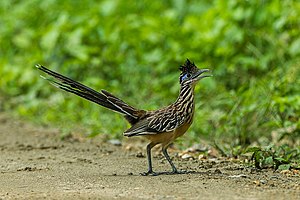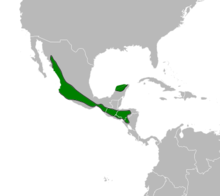Racing cuckoo
| Racing cuckoo | ||||||||||||
|---|---|---|---|---|---|---|---|---|---|---|---|---|

Racing cuckoo ( Geococcyx velox ) |
||||||||||||
| Systematics | ||||||||||||
|
||||||||||||
| Scientific name | ||||||||||||
| Geococcyx velox | ||||||||||||
| ( Wagner , 1836) |
The racing cuckoo ( Geococcyx velox ) is a medium-sized, long-legged representative of the cuckoo birds (Cuculiformes), which occurs in southern North America and in Central America. Unlike many other cuckoos, the racing cuckoo is not an obligatory brood parasite , but rather raises its offspring itself.
features
The racing cuckoo is a slender bird which, including its tail, reaches a body length of 46 to 51 centimeters; the tail is about 24 centimeters. This makes it a little smaller than its closest relative, the path cuckoo ( Geococcyx californianus ). The range of the two species overlaps in parts of Mexico. The two species are similar, but the plumage of the racing cuckoo is more brownish on the rump and on the wings. In addition, the dotted lines are missing on the front neck and on the chest, which is very noticeable when cuckooing away.
The top of the head, the bonnet and the neck of the racing cuckoo are black with a bronze sheen and small light brown spots. The rear neck is black-brown, the feathers here are lined with pale brown, so that a brown-white dash is created. The plumage on the top of the body is dark brown with light speckles and lightens to a chestnut brown at the rump. The chest is white. The control springs are black with a dark purple sheen.
The iris is yellow to brown, a yellow to silvery-white ring surrounds the pupil. The orbital ring is pale lavender to bright blue. Behind the eye it is elongated to a narrow band, which merges into a bright red shade at the neck, but which is mostly covered by feathers. The upper beak is gray, the lower beak blue-gray.
Young birds are similar to the adult birds, but have ocher-colored dashes.
distribution and habitat
The racing cuckoo lives in arid and semi-arid open landscapes . The distribution area extends in Mexico from the south of the Sonoran Desert along the Pacific Ocean to Guatemala , Honduras and northern Nicaragua . There is also a disjoint occurrence in the north-west of the Yucatán Peninsula .
The population size is estimated at 500,000 to 5 million individuals. In addition, the distribution area is very large, so that the IUCN assesses the species as not endangered (“least concern”).
Way of life
The racing cuckoo usually moves on the ground. Even when there is danger, the cuckoo runs into thick vegetation instead of flying. The racing cuckoo's main food is insects such as short-antennae terrors , ants and caterpillars as well as small lizards . It is not a breeding parasite , both parents raise the young together.
literature
- Johannes Erritzøe , Clive F. Mann, Frederik Brammer, Richard A. Fuller: Cuckoos of the World (Helm Identification Guides) . Christopher Helm Publishers Ltd, London 2012, ISBN 978-071-366-034-0 .
- Robert B. Payne: The Cuckoos (Bird Families of the World No. 15). Oxford University Press, Oxford 2005, ISBN 0-19-850213-3 .
Web links
- Geococcyx velox inthe IUCN 2013 Red List of Endangered Species . Listed by: BirdLife International, 2012. Retrieved November 24, 2013.
- BirdLife International: Species Factsheet - Lesser Roadrunner ( Geococcyx velox ) . Retrieved September 26, 2013.
- Videos, photos and sound recordings of Lesser Roadrunner (Geococcyx velox) in the Internet Bird Collection
- Racing cuckoo ( Geococcyx velox ) at Avibase; Retrieved September 26, 2013.
- Geococcyx velox in the Integrated Taxonomic Information System (ITIS). Retrieved September 26, 2013.
- xeno-canto: sound recordings - Lesser Roadrunner ( Geococcyx velox )
Individual evidence
- ↑ a b c Erritzoe et al. P. 133.
- ↑ Geococcyx velox in the Red List of Threatened Species of the IUCN 2013. Posted by: BirdLife International, 2012. Accessed November 24, 2013.
- ↑ Erritzoe et al. Pp. 131-132

